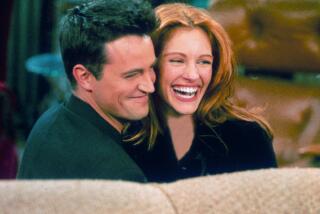‘Double Exposure’ offers a picture of the celebrity photo shoot
- Share via
Love it! Beautiful! That’s hot! Oh my God, that’s amazing!
There, do you feel special yet? Apparently, part of celebrity involves having a high tolerance for loudly yapped compliments while cameras are trained on you. On “Double Exposure” (Bravo, Tuesdays at 10 p.m.), which focuses on the behind-the-scenes lives of celebrity photographers Markus Klinko and Indrani, the praise rains down like automatic gunfire: It’s hard not to feel the instinct to get out of the way.
For eight years, this duo was romantically involved as well, but now it’s a strictly professional relationship. Naturally, this creates tension. Both are hopelessly petulant and manipulative, both on and off set. But that friction, which should theoretically be the animating force of this series, isn’t quite electric. In last week’s premiere episode, the couple’s main disagreement was about the relative sizes of their hotel rooms: She can’t fathom why hers is so much smaller, and he doesn’t care.
“People often think of our work as Markus’,” Indrani complains, “and they don’t realize I’m at least 50% of every image.” A fair complaint, to be sure, and as if to emphasize Indrani’s hard work, next week she is depicted slaving over post-shoot logistics and technology while Klinko goes out to dinner with singer-celebrity Aubrey O’Day. (They shot O’Day’s Playboy pictorial last year.)
But where “Double Exposure” is more effective is as a document of how your celebrity-image sausage gets made. Certainly not all photo shoots are as chaotic as the ones portrayed here, but plenty are. Whether it’s a mouthy client like German fashion designer Kai Kuhne or a brash, boundary-less magazine executive such as Luis Barajas of Flaunt, who appears next week, or a celebrity’s publicist attempting to pull strings behind the scenes to keep their client looking good, there are far more obstacles to getting a stellar photograph besides the quality of equipment and lighting.
“Yes, we dress girls up. Yes, we have hair and makeup and all that,” Klinko says, “but the real essence of what we do is we are professional seducers. It’s about turning people on and making them aroused and making them, like, ‘Wow, this is cool. I wanna look like that, I wanna be like that.’”
On set, Klinko does the loud yapping, but also much of the flirting. Indrani sighs for the cameras: “Markus wants to take them home afterwards as well, and that’s not always the best course of action.”
But Klinko’s alleged lothario-ness doesn’t appear to be much of an obstacle. If anything, clients notice Indrani, a former model, far more.
And besides, they’re only two of several people on any given set, any of whom can steer things into an uncomfortable direction. These shoots are complex ecosystems, and require orchestral precision.
Add to this the additional layer of reality-show cameras capturing the shoot, and it becomes even tougher, to say nothing of the fact that magazines willing to let outsiders film their photo shoots are few and far between.
What arrives on “Double Exposure,” then, are scenes in which everybody needs something. In the premiere episode, it was a shoot with Eve, the rapper still trying to establish herself as an actress, done for Women’s Health magazine, not a major fashion player. This week, it’s a pair of young stars — Jessica Stroup from “90210” and Armie Hammer from “Gossip Girl” — shooting for the small Los Angeles-based style-and-entertainment magazine Flaunt. Klinko and Indrani have shot for Vanity Fair and Vogue, but those magazines require a seamlessness that this show can’t bear, and reveals to be false anyhow.
Up until a show like “Double Exposure,” the image that appeared in print had the final word. But now the back story matters: Flawless celebrity portraits have scars too, and increasingly, they’re on display.
After watching “Double Exposure,” you begin to feel bad for the celebrities, actually, for what they have to put up with to maintain that image of perfection. Perhaps that’s the tipping point for a cultural course correction back toward the value of artifice.
More to Read
The complete guide to home viewing
Get Screen Gab for everything about the TV shows and streaming movies everyone’s talking about.
You may occasionally receive promotional content from the Los Angeles Times.






